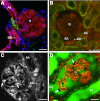The first decade of using multiphoton microscopy for high-power kidney imaging
- PMID: 22031850
- PMCID: PMC3340919
- DOI: 10.1152/ajprenal.00561.2011
The first decade of using multiphoton microscopy for high-power kidney imaging
Abstract
In this review, we highlight the major scientific breakthroughs in kidney research achieved using multiphoton microscopy (MPM) and summarize the milestones in the technological development of kidney MPM during the past 10 years. Since more and more renal laboratories invest in MPM worldwide, we discuss future directions and provide practical, useful tips and examples for the application of this still-emerging optical sectioning technology. Advantages of using MPM in various kidney preparations that range from freshly dissected individual glomeruli or the whole kidney in vitro to MPM of the intact mouse and rat kidney in vivo are reviewed. Potential combinations of MPM with micromanipulation techniques including microperfusion and micropuncture are also included. However, we emphasize the most advanced and complex, quantitative in vivo imaging applications as the ultimate use of MPM since the true mandate of this technology is to look inside intact organs in live animals and humans.
Figures






References
-
- Basile DP, Friedrich JL, Spahic J, Knipe N, Mang H, Leonard EC, Changizi-Ashtiyani S, Bacallao RL, Molitoris BA, Sutton TA. Impaired endothelial proliferation and mesenchymal transition contribute to vascular rarefaction following acute kidney injury. Am J Physiol Renal Physiol 300:F721–F733, 2011 - PMC - PubMed
-
- Comper WD, Osicka TM, Russo LM. Renal filtration, transport, and metabolism of albumin and albuminuria. In: Seldin and Giebisch's The Kidney Physiology and Pathophysiology, edited by Alpern RJ, Hebert SC. New York: Academic, 2008, p. 2081–2112
-
- Curley PF, Ferguson AI. Actively mode-locked Ti:sapphire laser producing transform-limited pulses of 150-fs duration. Opt Lett 16:1016–1018, 1991 - PubMed
-
- Denk W, Strickler J, Webb W. Two-photon laser scanning fluorescence microscopy. Science 248:73–76, 1990 - PubMed
Publication types
MeSH terms
Grants and funding
LinkOut - more resources
Full Text Sources
Miscellaneous

